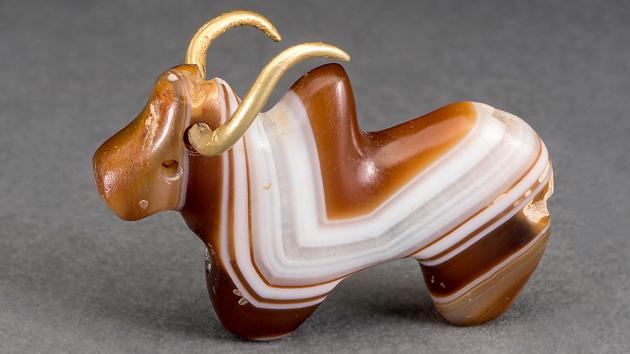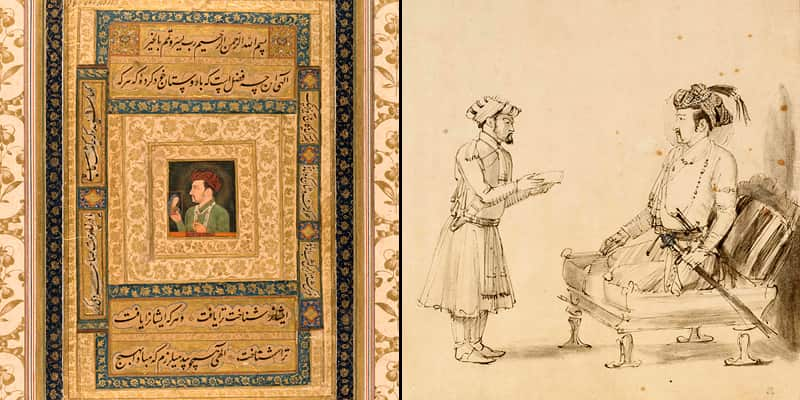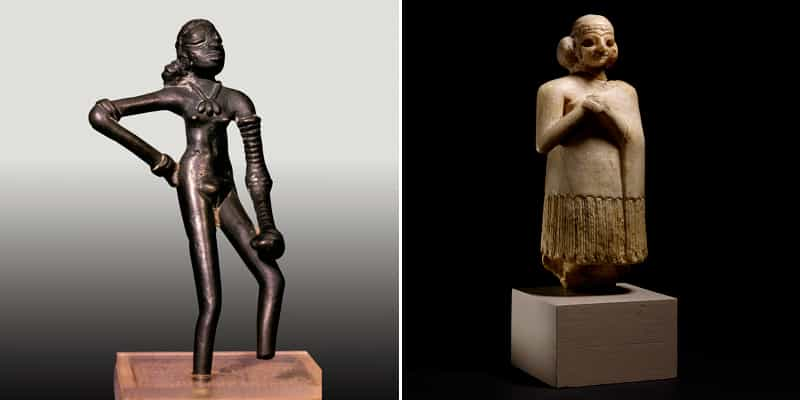The spectacular exhibition India and the World reaches Delhi
India and the World, a mammoth, spectacular exhibition, comes to Delhi, with its fascinating stories of how we share our past with continents, countries and people in ways we cannot imagine
The 200-odd pieces on display at the India and the World convey that we share our history and legacy with continents, countries and people in way we cannot even imagine.

Journalist Italo Calvino wrote in Invisible Cities, ‘The more one was lost in unfamiliar quarters of distant cities, the more one understood the other cities he had crossed to arrive there’. Identity and history were in the past elemental to sharing a present. But they have of late become a battleground for assertion, chief among them of the idea that all nations were perhaps islands that survived and thrived all on their own. “We were all migrants,” Naman Ahuja says, as we meet in the lawns of the National Museum. It is eerily quiet for a summer afternoon, a far cry from the exhausting last couple of months he has spent. Ahuja is co-curator of India and the World: A History in Nine Stories, a mammoth, time-travelling, crossover epic of an exhibition that will set foot in the national capital this week.
THE GENESIS
The seed for India and the World was sowed back in 2010, with the former director of the British Museum Neil MacGregor’s landmark book A History of the World in 100 Objects. “The book and the exhibition were a huge hit,” Naman says. “A lot of museums across the world wanted to have similar exhibitions. But when the idea was mooted in the context of India, many people suggested that Indians would be more interested in learning about their own country. The core team, which included MacGregor, decided to then call it India and the World, and look at India’s history in relation with the outside.

The exhibition, a collaboration between the Chhatrapati Shivaji Maharaj Vastu Sangrahalaya (CSMVS) of Mumbai, the British Museum (BM) and the National Museum, Delhi (NMD), has taken three years to come to fruition. Of the 200-odd pieces on display, several have been loaned from an additional 20 institutions or collections. It is a colossal effort. “There wasn’t a day when we were not working. There were teams in Delhi, Mumbai and London, constantly meeting and planning. The list of objects, and the stories we wanted to do, were finalised after several curatorial meetings,” Ahuja says. Having co-curated with the British Museum’s JD Hill, Ahuja admits that disagreements were inevitable and welcome.”Every time I was raising the bar to say something that hadn’t already been said in the Indian context, it was natural that the same would happen for the world from his side. How else could we have had a rewarding conversation?”
SHARED HISTORY
India and the World is divided into nine broad sections, and the story of each section is told through objects and artefacts that date back thousands of years. Its intention is to juxtapose parallel histories to offer a way out of the isolated view we have come to cultivate of ourselves in recent times. But while some objects talk to each other right away, there is a case for things that seem incontrovertibly impossible to connect. “We have to accept in certain cases, for example with the dancing girl of Mohenjo Daro, that at some point our idea of culture, time and faith was indeed different,” Ahuja says. The last leg of the exhibition titled ‘Time Unbound’ hits home the idea of this uniqueness and in a way, Naman says, even questions the premise of the exhibition. “When even our idea of time and calendars is different, how can we assimilate everything into one,” he adds.

As for the shared histories, nothing is perhaps as inseparable from India as its painful colonial past, something the British Museum has done an admirable job of confronting in the section ‘Quest for Freedom’ that focuses on the Empire’s imperial legacy. “This exhibition is the result of equal partnership between the BM, the CSMVS and NMD. We wanted to use objects to look at key moments in Indian history in the context of world history. The exhibition does not shy away from difficult periods of colonial/imperial history which are integral to India’s past and present and these are represented through objects in the exhibition,” says Dr Hartwig Fischer, director, British Museum.
The idea that India not only lent, but also borrowed, in terms of culture and trade, isn’t a popular one these days. Superiority, it seems, has come to pass as the sole objective of inquiring the past. How then does one reconcile an exhibition like this that challenges a popular notion? “A Deccani textile, by the name of Kalamkari [Indian Ocean Traders section] shows a sanyasi. We have always heard stories of how the sanyasi is distracted in his tapasyaby an apsara. But if you look closely, you see him marvelling at a pineapple. It is evidence of a newfound love, of curious wonder at something that has appeared out of nowhere. Pineapples were of course imported, indicating how India had begun to trade and expand its network as early as the 1600s,” Ahuja says.
The exhibition best presents the idea of shared histories and cultures through its many juxtapositions. A curious Rembrandt painting of Jahangir receiving an officer alongside a watercolour painting of the emperor holding a portrait of the Virgin Mary is a wonderful conversational piece about cultural overlap. Rembrandt famously of course studied Mughal miniatures. A statue of Nataraj (Shiva) alongside a crucifix discovered in France, from roughly the same period, show how contrastingly we see those we seek to worship - positions of strength or vulnerability.
Of the many novel approaches employed in the exhibition, including an effort to look beyond city-centric histories in ‘First Cities’ and mapping parallels in the propagation of religion through ‘State and Faith’, perhaps the most crucial is the re-positioning of certain ideas from the perspective of women. “There is massive scope to think about history from a feminine point of view,” says Ahuja, “When you think of the nature of people, and the bodies that are taken as evidence, we discount the fact that women were not allowed inside temples at a point of time. Everything true of a temple is considered true for the whole country. But when you consider that that is obviously not true, nothing remains to show for the history of the others, like that of women.”
STITCHING THE PAST
The scale of exhibition is such that it was inevitable that certain moving parts were either to start creaking or simply fall out. Scheduled to open in March in Delhi, after it travelled from CSMVS in Mumbai, the exhibition has already suffered from delays and logistical issues leading to some artefacts and pieces failing to make it to the Delhi leg. “Certain objects were too heavy and difficult to move. It was impossible to fly them in. They were first supposed to go to Dubai, but eventually the British Museum took the decision to fly them back home,” says Dr BR Mani, director of the National Museum. Mani also believes that certain objects were unnecessary and in one case even derogatory, to be included in the exhibition. “We only wanted things that were relevant to the exhibition,” he says about a piece titled Unicode, by artist LN Tallur, “so we took a call on a couple of things. It is a huge effort to get everything in place. We have been given so little time.” But Mani is optimistic about the possibilities of large crowds visiting the museum despite the simmering heat of Delhi’s summer.

Hill and Ahuja’s task can be adjudged by the fact that they had to carefully curate lists and have three to four backup options for each object they wanted to bring in. For example, folios from the Baburnama had to be used instead of the Akbarnama, because the latter was in too delicate a condition to be transported from Patna. But not all challenges are logistical. Sometimes ideas can be so overwhelming, it becomes difficult to convey them convincingly. “I think that was one of the biggest challenges. To not lose the idea, but speak in a language that everyone understood. I must be honest, it is demoralising at times, but I would still say, come and see it once. Don’t make up your mind. I am just giving you a new way to look at the world. I am not saying I know it all. I know I don’t,” Ahuja says. India and the World, given its ambition and scale, is perhaps the longest journey you can take, under one roof. It seeks to unravel, to explore, to question because in a time where history has become the language of politics, it is important to know all sides, for as Calvino wrote, ‘There is no language without deceit’.
—Visitors to the exhibition can buy a sumptuous 230-page all-colour catalogue of India and the World – A History in Nine Stories, published by Penguin. It has beautiful pictures of the exhibits with accompanying text, written by Prof Naman Ahuja and J.D Hill, which gives wonderful details about each exhibit as also their significance in the India’s millennia-old connectedness with the world.
WHAT: Exhibition India and the World: A History in Nine Stories
WHEN: Till 30th June, 10 am - 6 pm (Mondays closed). Entry with museum ticket.
WHERE: Special Exhibition Hall, First Floor, National Museum, near India Gate, Delhi
Catch your daily dose of Fashion, Health, Festivals, Travel, Relationship, Recipe and all the other Latest Lifestyle News on Hindustan Times Website and APPs.



